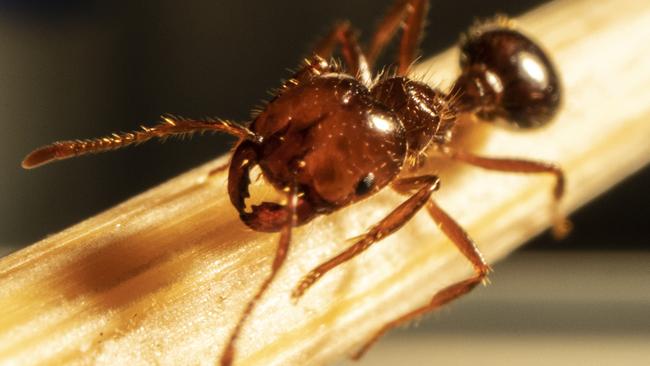Fire ants making rafts to escape floodwater pose heightened spread risk
Fire ants clumping together in thousands to make a raft to escape floodwaters in northern NSW have Invasive Species spooked – but the National Eradication program says there is nothing to worry about.
Tweed Heads
Don't miss out on the headlines from Tweed Heads. Followed categories will be added to My News.
Wet weather in the state’s north has enabled red imported fire ants (RIFA) to amass in clumps and form rafts in Queensland and northern NSW floodwaters, sparking fears of further incursions.
The venomous pest was captured on video amassed together in thousands floating in floodwaters around the Gold Coast on Tuesday.
Invasive Species Council Advocacy Manager Reece Pianta said this was the first time he had seen this adaptive behaviour in Australia.
“The recent heavy rainfall and wild weather in the region could accelerate the spread of fire ants, one of the world’s worst invasive species,” he said.
“Fire ants are more active before or after rainfall and can form large floating rafts which move with water currents to establish footholds in new areas.”
Mr Pianta said there was recent evidence of this rafting behaviour on cane farms south of Brisbane.

The ants work in highly cooperative super-colonies that swarm in the hundreds of thousands, relentlessly stinging everything in their path.
He said there is a real concern the ants will wash down to low-lying wetlands, beaches and coastal habitat areas.
“The community has an essential role in eradicating fire ants - stay vigilant and report any suspect ants that appear after rainfall events,” Mr Pianta said.
“Eradication is the only way to stop the spread of fire ants and suppression work inside the fire ant zones needs to be ramped up.”
Control of the pest is being handled by the National Fire Ant Eradication Program who are working alongside the NSW DPI as the lead agencies.
National Fire Ant Eradication Program spokesman said the ants are “highly adaptive” to their environment and during wet weather can survive slow-moving flood waters by forming “rafts”.
“Rafting is a last-resort method of survival as it has major risks for the colony,” the spokesman said.
“If the water moves too fast or the colony becomes submerged for a long period, the raft can break apart and the ants will not survive.
“Flood waters in the current fire ant infestation area in southeast Queensland generally move in a west-to-east direction towards the ocean, yet while it is possible that fire ants can spread in flood waters, at present this doesn’t pose a major risk of them spreading further across Australia.”
He said fire ants often build their nests higher during wet weather making them more visible, and now is a good time to check your property for fire ants.

In a statement, NSW DPI’s chief invasive species officer Scott Charlton said the state government is working to eradicate fire ants from NSW following their detection in South Murwillumbah last November.
“As the Invasive Species Council has quoted, it is possible for fire ants to adapt to wet conditions through their colonies’ rafting mechanism,” Mr Charlton said.
“However in the case of South Murwillumbah, due to the topography around the infested premises and the fact no further fire ants have been detected means it is very unlikely this would occur.”
Mr Charlton also praised the community response to the fire ant threat.
“(We’ve) spoken to over 1200 people in the local area and received over 500 calls primarily of suspected fire ant reports (all negative),” he said.
Any suspected sighting of fire ants should be reported immediately to NSW DPI by visiting dpi.nsw.gov.au or calling 1800 680 244.




